Exploring the Facets of Brilliant Cut Diamonds
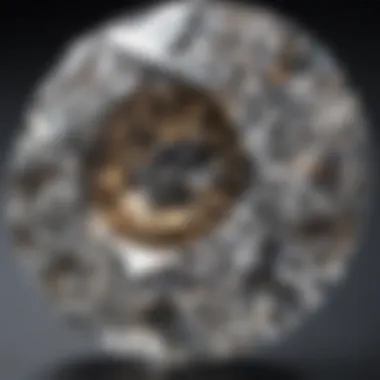
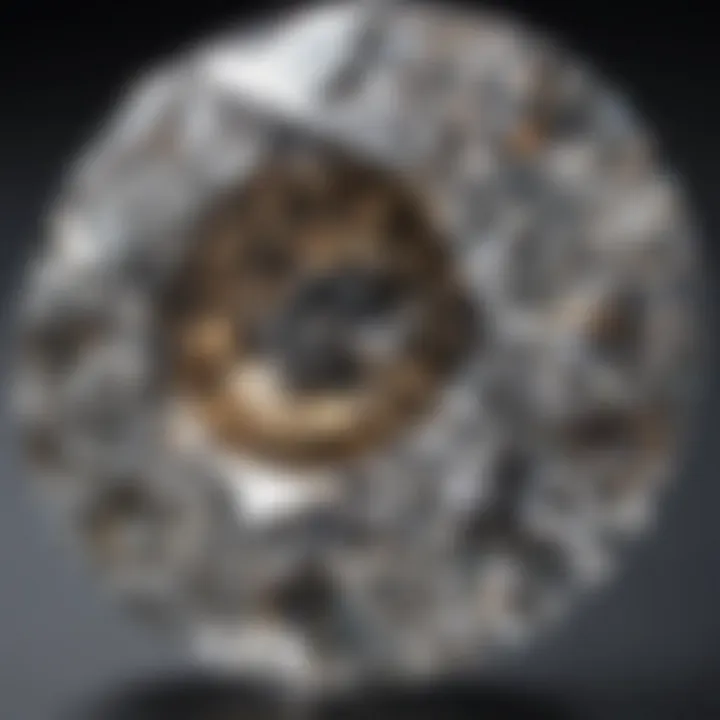
Intro
When one gazes at a diamond, particularly a brilliant cut, the light show that dances across its surface is nothing short of mesmerizing. This is more than just a pretty stone; it’s a marvel of artistry and science combined. The intricate facets, shaped with precision, play a crucial role in how a diamond sparkles and shines. Understanding these facets can significantly enhance your appreciation of both their beauty and their underlying craftsmanship.
The quest for creating the perfect diamond has a rich history, and the brilliant cut stands out as a pinnacle of this journey. Every facet is strategically placed to maximize the reflection and refraction of light, creating a glittering effect that draws the eye. Let’s dig deeper into the remarkable world of brilliant cut diamonds and see what makes them so compelling.
Gemstone Overview
Definition and Characteristics
Diamonds, in their essence, are composed of carbon atoms arranged in a crystal lattice structure, making them the hardest natural material known to humanity. The brilliance of a diamond, especially the brilliant cut, is primarily due to its unique faceting. With typically 57 facets, the light entering a diamond reflects internally, creating a rainbow of colors that are often exhilarating.
Characteristics of brilliant cut diamonds include:
- Cut Quality: How well the facets are shaped and aligned affects the diamond’s visual appeal.
- Color: The less color a diamond has, the higher its grade. D (colorless) to Z (light yellow) is the typical scale used.
- Clarity: Flaws, known as inclusions, are examined under 10x magnification. Simply put, the fewer the flaws, the more valuable the diamond.
- Carat Weight: Size matters; the weight of diamonds is measured in carats, with one carat equaling 0.2 grams.
Classification of Gemstones
Gemstones can be broadly classified into two categories: precious and semi-precious. Diamonds fall into the precious category, alongside rubies, sapphires, and emeralds. This classification often hinges not only on rarity but also on the stone's inherent qualities like hardness and brilliance.
Other fascinating categories can include:
- Organic Gemstones: Such as pearls and amber, which are formed from living organisms.
- Synthetic Gemstones: Man-made stones that mimic the properties of natural gems, like moissanite, which can often be mistaken for diamonds at first glance.
Understanding these classifications provides context for appreciating the unique qualities of each stone and where diamonds fit within this broader framework.
"A diamond’s cut can affect its brilliance and ultimately its value; the right knowledge can turn a diamond buyer into a diamond enthusiast."
Historical Significance
Ancient Uses and Cultural Importance
Diamonds have been revered across cultures for centuries, believed to possess mystical properties. In ancient India, diamonds were thought to protect warriors in battle and were worn for their supposed ability to ward off evil spirits. Similarly, the Romans believed that diamonds were tears of the gods, symbolizing invincibility.
The allure of diamonds also found its way into art and literature, often representing purity, strength, and wealth. Today, they are synonymous with promises and commitments, frequently marking the beginning of lifelong partnerships.
Myths and Legends Surrounding Gemstones
Throughout history, myths and legends about gemstones abound, with diamonds taking center stage. The stone is often associated with transparency, purity, and unyielding strength. Various cultures have developed their interpretations, suggesting that wearing a diamond could lead to invulnerability in battle or the revelation of truth in one's heart.
This exploration into the historical narratives surrounding diamonds not only enhances our understanding of their significance but also enriches our experience when we hold one in our hands today.
Preamble to Brilliant Cut Diamonds
Brilliant cut diamonds hold a place of significance in the world of gemstones and jewelry. Their popularity isn’t just a matter of aesthetics; it’s about the interplay between light and the diamond's intricate design. Recognizing the brilliance in a diamond goes hand in hand with understanding what makes these cuts distinct and desirable.
To many, the term "brilliant cut" conveys a certain sparkle that is almost mesmerizing. It's not just the shape; the faceting plays a crucial role. The precision of these facets determines how light reflects and refracts through the stone, giving it an unmatched brilliance. Each cut is designed with an aim: maximizing light performance to create that sought-after shine. Such depth isn’t merely for looks; it brings value to the gem, embellishing its status as a sought-after object.
A good grasp of the facets in a brilliant cut diamond helps consumers, collectors, and jewelry designers make informed choices. It opens up a deeper understanding of what aspect affects quality and desirability. Not all cuts are made equal, and knowing the reasons behind the shaping of these gems can enhance one's appreciation for craftsmanship and artistry.
In this section, we will explore the essence of faceting within diamonds and highlight its importance in establishing quality and aesthetics. This sets the stage for the detailed examination of facets, their variations, and light performance in the following segments.
Understanding the Concept of Faceting
When discussing brilliant cuts, it’s essential to grasp what faceting actually entails. Faceting refers to the arrangement and structure of the flat surfaces—known as facets—on the diamond. These are meticulously placed to harness light and create the characteristic sparkle. Picture a diamond as a finely crafted mosaic; every facet acts like a small mirror, bouncing light around and creating an interplay of reflections.
Traditional brilliant cuts typically feature a collection of 57 or 58 facets, including the table on top and the pointed pavilion at the bottom. Each of these facets has a precise angle and location, calculated to optimize the diamond's visual appeal. It's worth noting that the way these facets interact with light can lead to various effects, such as brilliance (white light reflection), fire (color dispersion), and scintillation (the play of light and shadow).
In simpler terms, the number and position of facets define how well a diamond will sparkle when it catches the light. This process creates what is often termed the diamond's “fire,” and it’s this that can leave listeners awestruck during engagement ring proposals or significant celebrations.
Yet, not all facets serve the same purpose. Some of them are carved out with precision to lure in light, while others enhance the depth of the gem or smooth its surface. Understanding this can empower both buyers and enthusiasts to make choices that aren't merely based on appearance but also on the science behind crafting these sparkling jewels.
Significance of Cut Quality in Diamonds
Cut quality is perhaps one of the most scrutinized aspects when it comes to grading diamonds. Unlike color or clarity, which can sometimes feel more subjective, cut quality is grounded in quantifiable measurements. This includes the proportions and angles of the facets, ensuring they align properly to maximize light reflection. A well-cut diamond can significantly elevate its perceived value and visual allure.
Cut quality hinges on a few key factors:
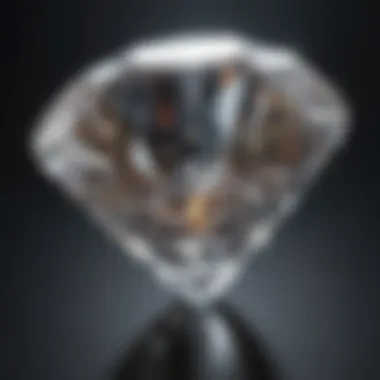
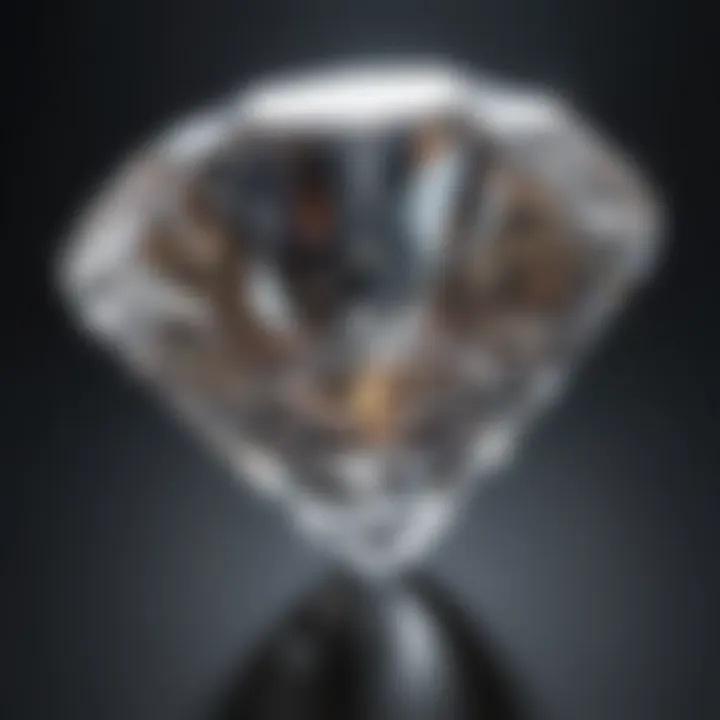
- Proportions: This refers to the relationship between different parts of the diamond, such as the height, width, and depth. If the proportions are off, the diamond may appear dull and lifeless.
- Symmetry: Symmetry focuses on how well the facets are arranged. Even minor discrepancies can drastically affect the sparkle.
- Finish: A diamond’s polish also plays into cut quality; it should be free from scratches or other imperfections that could dull its shine.
Ultimately, the cut quality does more than just enhance appearance. It affects how a diamond performs in terms of light play. A “poorly cut” diamond—regardless of its other qualities—won't exhibit the brilliance one might expect, and in turn, it may not hold its value in the competitive market.
Understanding these aspects is crucial for anyone involved in the diamond industry or simply those with a passion for them. The clearer the understanding of how cut quality influences appearance and value, the better equipped one will be to appreciate or choose that perfect piece.
Historical Context of Brilliant Cuts
When diving into the world of diamonds, understanding the historical context of brilliant cuts gives one a solid foundation. Diamond cutting is not merely a technical endeavor; it is entwined with the very fabric of culture and status throughout history. This exploration reveals how brilliant cuts emerged, shaped the diamond trade, and influenced societal values.
Evolution of Diamond Cutting Techniques
The journey of diamond cutting techniques can be traced back to ancient civilizations, where the raw natural beauty of uncut stones was celebrated. However, it wasn’t until the late Middle Ages that diamond cutting began to evolve significantly. The initial techniques were rudimentary. Jewelers typically relied on simple grinding and polishing methods, leading to dull and lackluster outcomes.
The pivotal moment came with the invention of the Rose Cut in the 16th century. This design featured a flat bottom and a faceted dome, allowing light to reflect in a captivating manner, albeit still lacking the brilliance of modern cuts. The breakthrough truly arrived with the Brilliant Cut around the 18th century. Inspired by the need for maximum light reflection, this cut added multiple facets on both the crown and pavilion of the diamond.
As tools advanced, cutters began to refine their techniques. The introduction of the brilliancy over fire method became game-changing. By mastering the angles and shaping of the facets, cutters could manipulate light, creating what has now become the standard for modern diamond cutting. Today, master cutters employ precision tools, advanced software, and innovative techniques, continuously evolving the art.
Influential Figures in Diamond Cutting History
Moving beyond techniques, figures in history played key roles in advancing diamond cutting practices. One notable individual is Lazare Kaplan, whose contributions in the early 20th century revolutionized the diamond industry. He introduced the "ideal cut" that maximized brilliancy through precise proportions. Kaplan's ideas not only set new standards for the quality of diamonds but also laid the groundwork for future evaluations of cut quality in the diamond market.
Another significant figure is Marcel Tolkowsky, often hailed as the father of the modern brilliant cut. In 1919, Tolkowsky published a comprehensive study that meticulously analyzed angles and proportions, resulting in the popularization of the round brilliant cut that we know today. His mathematical approach infused the process with a scientific rigor that was previously absent, allowing jewelers to create diamonds that sparkled and shone like never before.
The evolution of cutting techniques and the influence of these historical figures emphasize the intrinsic value placed on diamonds throughout time. The journey from a simple stone to a meticulously crafted masterpiece underlines not only advancements in technology but also the deep cultural significance and the craftsmanship embedded in each facet.
"The diamond cutting process is not merely technical; it is a blend of art and science that reflects both human ingenuity and cultural evolution."
In summary, the historical context of brilliant cuts is essential in understanding their present significance. The interplay of technique and the influence of visionaries shaped a craft that continues to captivate the world, intertwining history with modern elegance.
Facets in a Brilliant Cut Diamond
The facets of a brilliant cut diamond stand as the unsung heroes behind the stone’s mesmerizing allure. Each facet, meticulously crafted, plays a significant role in how light interacts with the diamond, ultimately defining its brilliance and fire. Understanding these facets not only enhances appreciation for these gems but also aids in making informed buying decisions. The journey of exploring facets begins with grasping their definition, followed by the specifics of typical configurations and variations that bring character to brilliant cuts.
Defining Facets: What Are They?
At its core, a facet refers to a flat surface on the exterior of a diamond, designed to reflect and refract light. When light enters a diamond, it bounces off these facets, creating a sparkle that enchants viewers. Think of facets as the diamond’s windows, reflecting the world outside and illuminating the gem from within. Each facet’s angle and orientation dictate how efficiently light travels through the diamond—after all, a well-placed facet can mean the difference between a dull stone and one that sparkles like the night sky.
Number of Facets in Standard Brilliant Cuts
In the realm of standard brilliant cuts, the number of facets is typically set at 58. This includes both the crown, which is the upper portion, and the pavilion, the section below. More specifically, the classic round brilliant cut displays:
- 33 crown facets
- 25 pavilion facets
- 1 culet facet (the tiny flat point at the bottom)
This multi-faceted structure allows for maximum light reflection and is fundamental to achieving that coveted brilliance. The intricate arrangement serves both aesthetic and practical purposes, as it guides light to dance within the stone. Notably, the delicate interplay of these facets is not just a matter of numbers; the angles and proportions also significantly contribute to the diamond's overall sparkle.
Common Variations in Faceting
Faceting isn’t a one-size-fits-all approach; there are various styles beyond the standard configuration. Each style brings its essence and enhances the diamond's character. Here are a few notable variations:
- Princess Cut: This contemporary cut features sharp, angular facets that add modern charm and tremendous sparkle. The cut typically has 76 facets, which amplifies its brilliance.
- Emerald Cut: Distinguished by its rectangular shape and step-style facets, this cut showcases the clarity of the diamond. It usually comprises 58 facets but has a lucid, reflective appearance due to its large, open table.
- Asscher Cut: Similar to the emerald, this cut has more elaborate facets, generating a unique optical effect. It typically features around 58 facets as well, but its square profile allows for a different light reflection quality.
Each variation offers distinct advantages and appeals, catering to a variety of tastes and preferences. Understanding these nuances aids both consumers and collectors in their search for the perfect diamond.
It’s essential to remember that while the number and type of facets are important, the quality of the cut itself will have the greatest impact on a diamond’s brilliance.
Exploring the intricate dynamics of facets will deepen one’s appreciation for the artistry and science behind diamond cutting, ultimately making for a more fulfilling experience when choosing a brilliant cut diamond.
Light Performance and Facets
When discussing brilliant cut diamonds, one cannot overlook the tremendous impact of light performance on their overall allure. Light performance refers to how a diamond interacts with light, affecting its appearance, and the facets are critical elements in this interplay. A well-cut diamond exhibits brilliance, fire, and scintillation, creating a mesmerizing visual experience that captures the eye. Understanding these aspects is pivotal for anyone interested in gemstones, whether as enthusiasts or collectors.
How Facets Influence Sparkle and Fire
Facets are the geometric planes on a diamond’s surface, precisely shaped and positioned to enhance light interaction. When light strikes a facet, it can either reflect off or be refracted through the diamond, giving rise to two critical characteristics: sparkle and fire.
Sparkle refers to the white light that bounces back to the observer, while fire represents the colorful flashes generated by the dispersion of light into its constituent colors.
- Round brilliant cuts can have up to 58 facets, allowing for impressive sparkle. Each facet’s angle and size are calculated to maximize the diamond's optical performance.
- Conversely, a poorly cut diamond with inadequate faceting might appear dull, losing the vibrancy desired in these precious stones.

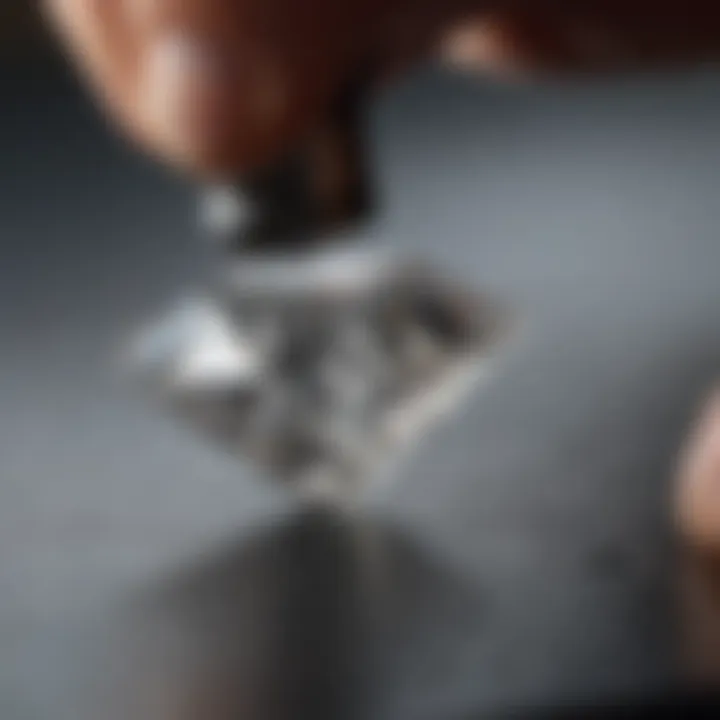
"The combination of well-angled facets and precise cuts creates a dance of light and color, elevating the diamond from mere stone to a masterpiece."
To truly appreciate the brilliance of a diamond, one must consider the number and arrangement of its facets, as they play a significant role in how much light is reflected. More facets can mean more light interactions, but without the right angles, they may not yield the desired effect.
The Role of Angle and Proportions
The angle and proportions of a diamond's facets significantly influence its ability to handle light. Each brilliant cut is designed with specific proportions that determine how light travels through the stone and reflects off its surface.
- Crown Angle: The angle at which the facets on the crown are cut affects how light enters the diamond. A crown angle that's too steep might limit light return, leading to a less brilliant appearance.
- Pavilion Angle: Meanwhile, a pavilion angle must be precisely calculated; if it's too shallow, light may escape rather than reflecting back to the viewer.
Achieving the ideal proportions is not a simple formula; rather, it requires a delicate balance that depends on the overall craftsmanship of the cutter.
Understanding the significance of angling and proportions is essential for buyers and collectors:
- Buyers can appreciate why some diamonds are more valuable than others based on their light performance.
- Collectors can identify quality diamonds by assessing their angles and overall proportions.
In summary, the relationship between facets, light performance, and angular proportions provides a comprehensive understanding for anyone looking to explore the depths of brilliant cut diamonds. Recognizing how each facet contributes to the diamond's overall sparkle and fire is more than just a matter of aesthetics; it’s foundational to appreciating these gemstones in their fullest glory.
Artistry in Diamond Cutting
The realm of diamond cutting isn't merely a technical exercise; it's an art form that transforms raw stones into dazzling masterpieces. The artistry involved in crafting a brilliant cut diamond is crucial to its appeal and market value. This process requires not only skill but also a keen aesthetic sense and understanding of light dynamics. The master cutter interprets the stone's natural characteristics and surroundings, drawing out its best features to maximize brilliance and fire.
One key element is the delicate balance between preserving the diamond's weight and enhancing its overall appearance. After all, a well-crafted diamond sings when light dances through its facets. Here’s where art meets science: by studying the stone’s internal structure, the cutter can determine the perfect angles for the facets, ensuring optimal light reflection. The dedication to precision in diamond cutting means that each turn of the wheel can significantly alter the final product, highlighting the importance of the cutter’s expertise.
In this discussion, we focus on two main aspects that embody this artistry—the unique skills of master cutters and how modern methods stand in comparison to traditional techniques.
The Skill of the Master Cutter
Every master cutter is both an artist and a scientist. To achieve a high-quality cut, they must understand the optical principles that govern light interaction with diamonds. They start with a rough stone, assessing its imperfections, inclusions, and overall size. The skill lies in determining which facets will bring out the diamond's natural beauty while minimizing losses due to cutting. This requires years of training and experience, as well as a natural affinity for gemology and geometry.
The technique involves meticulous cutting and polishing, with an eye always on the end product's aesthetics. Master cutters often use traditional tools alongside modern technology, blending their expertise with innovations to achieve stunning results. A precise cut can evoke synergies that enhance the visual splendor of the diamond, leading to stunning gems that not only catch the eye but also tell a story through their glittering surface. Some key skills that highlight the cutter's expertise include:
- Analytical vision: The ability to visualize how a diamond's facets will interact with light.
- Technical accuracy: Mastery in operating cutting and polishing tools with precision.
- Aesthetic judgment: The talent to identify the most visually appealing angles and configurations.
Given the importance of the diamond’s cut, the role of the master cutter cannot be overstated; their decisions in the facet design shape the final outcome.
Modern Techniques vs. Traditional Methods
The debate between modern techniques and traditional diamond cutting methods is a lively one. Each approach has its own advocates, and there is merit in both.
Traditional methods involve hand-cutting and polishing with manual tools, allowing for a deeply personal touch. Many seasoned cutters maintain that this approach gives them more control over the subtle nuances of each diamond. They can make adjustments on the fly based on their intuition and experience. For them, it’s not just about the diamond; it’s about the relationship developed with each piece they work on.
On the other hand, modern techniques leverage high-tech machinery and computer-aided design software. This has resulted in unprecedented precision and speed in the cutting process. Advanced lasers can create facets that might be difficult or impossible to achieve by hand. For many in the industry, this method leads to diamonds of higher quality and consistency. The balance that modern tools bring to the cutting process often enhances the brilliance and fire of the final product.
Ultimately, the blend of tradition and innovation creates a rich tapestry in diamond cutting. As artisans continue to adapt, the fusion of old and new methods enriches the artistry found in brilliant cut diamonds.
"Artistry in diamond cutting is both an expression of human creativity and an application of scientific principles, making it one of the most fascinating aspects of gemstone craftsmanship."
The exploration of artistry in diamond cutting reveals layers of complexity that go beyond the surface shimmer. It's a deep dive into the fusion of skill and creativity, emphasizing how the facets we admire are the product of intensive labor, thoughtful design, and timeless tradition.
Brilliant Cut Variations and Their Facets
Understanding the variations of brilliant cut diamonds is crucial as these unique styles can significantly impact the perception of brilliance and overall value. Each variation reflects distinct design choices and techniques, resonating with personal preferences and market interpretations. Grasping these differences allows collectors and gem enthusiasts to make informed decisions, ensuring that their investment is well-aligned with their desired aesthetics.
Round Brilliant Cuts
Round brilliant cuts are perhaps the most widely recognized style in diamond cutting. Characterized by their circular shape, these diamonds contain a standard of 58 facets, optimizing the interaction of light in a stunning manner. The round brilliant’s design is meant for maximum sparkle, reflecting light from each angle and creating the famous fire that so many appreciate.
- History and Popularity: The round brilliant cut was developed in the early 1900s and has since become synonymous with diamond engagement rings. Jewellers often recommend them due to their timeless appeal and unmatched brilliance.
- Faceting: This cut consists of a table, crown, girdle, pavilion, and culet, where each facet is strategically placed. Those facets work harmoniously to enhance light performance, making a well-cut round diamond sparkle like nothing else. But, just because it’s popular doesn’t mean it’s simple to choose. Pay attention to cut quality – there's a world of difference between a great and a mediocre round brilliant.
Princess Cuts and Their Faceting
The princess cut has swiftly risen to fame, becoming a favorite among modern couples seeking a square or rectangular shape. This cut combines contemporary aesthetics with brilliant performance.
- Facet Structure: The princess cut typically features 76 facets, which maximize brilliance and create a unique light display. The combination of the sharp corners and tightly arranged facets can produce an exquisite reflection akin to a round brilliant but with a decidedly modern twist.
- Why Choose a Princess Cut?: If you're looking for something less traditional than a round cut yet still vibrant, the princess cut is an excellent choice. Its angularity offers an edgier appeal that resonates with youthful buyers or those looking to break away from old norms.
Other Popular Styles
Apart from round and princess cuts, there are several other popular faceted diamond styles that cater to different tastes and preferences. Some notable mentions include:
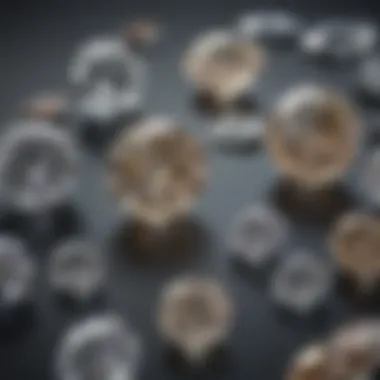
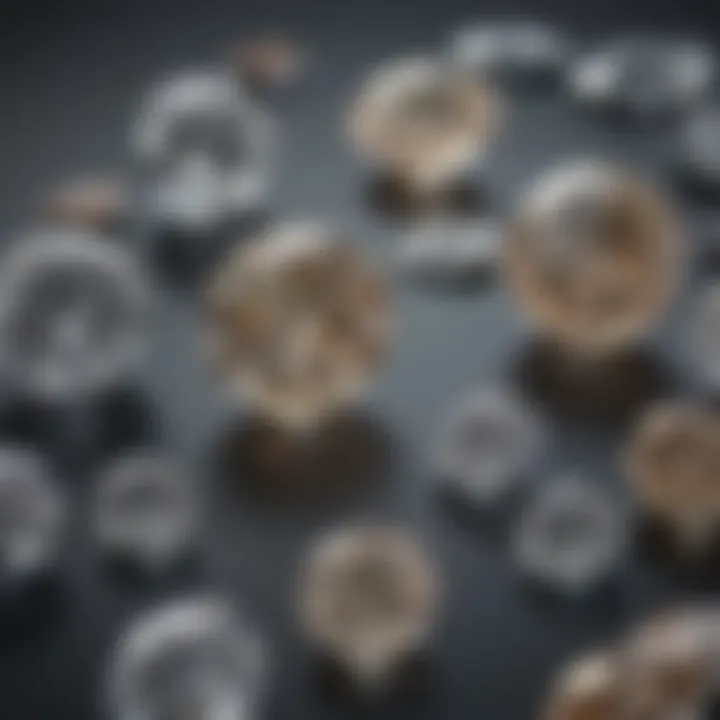
- Emerald Cut: Known for its rectangular shape and unique step-cut facets, the emerald cut emphasizes clarity and color rather than the traditional sparkle associated with brilliant cuts.
- Cushion Cut: This retro-style cut combines elements of both round and square shapes, often featuring rounded corners. It creates a romantic vintage look, appreciated for its soft curves and light performance.
- Asscher Cut: The asscher cut resembles the emerald cut but is square in shape. Its deep pavillion and unique facets reflect a mesmerizing depth that can captivate the eye.
Understanding these styles is important for anyone delving into the world of diamonds. Each cut reflects an array of faceting techniques that define its brilliance, making some styles more suitable for certain occasions or aesthetic preferences. By familiarizing oneself with these diamond variations, buyers feel better equipped to determine which cut aligns with their personal ideals in terms of visual appeal and investment value.
Considerations for Buyers
When contemplating the purchase of a brilliant cut diamond, the weight of your decision carries immense significance. These gems not only represent a considerable financial investment but also possess sentimental value that transcends generations. For buyers, understanding the intricacies of these diamonds—particularly the critical facets and how they influence quality—becomes essential.
Evaluating Cut Quality
Cut quality in a diamond is not merely a term; it embodies the artistry and skill that contribute to a gem's visual appeal. In the world of diamonds, the cut is perhaps the most vital factor affecting its overall brilliance and fire. The quality of the cut determines how well the diamond will reflect and refract light. For instance, a superbly cut diamond can appear larger and more luminous than its poorly cut counterpart, despite having the same carat weight.
To evaluate cut quality, one might consider the following:
- Proportions: Every facet's angle and size affect light performance. Ideal proportions can maximize brilliance.
- Symmetry: Well-aligned facets create a harmonious appearance. Imperfections here can detract significantly from appeal.
- Polish: Surface quality matters. A diamond with a high-quality polish will showcase its vividness better than one with surface blemishes.
Ultimately, assessing cut quality often requires viewing the diamond in various lighting conditions to truly appreciate its attributes. The brilliance should demand attention while simultaneously exuding a sense of balance and elegance.
Understanding Certification and Grading
Before making a purchase, it is wise to understand the certification and grading systems in place for diamonds. Certification acts as a validation by an independent gemological laboratory, detailing the stone's characteristics and quality. Reputable organizations, such as the Gemological Institute of America (GIA) or the American Society of Appraisers (ASA), maintain rigorous standards in their assessments.
Key elements to consider regarding certification include:
- Transparency: A diamond's certificate should provide clear details on its carat weight, color, clarity, and cut. This transparency assists in making informed decisions.
- Reputation of the Laboratory: Choose diamonds certified by renowned labs. A certificate from GIA is highly coveted in the marketplace.
- Grading Scale: Familiarize yourself with the grading scale utilized. Understanding how diamond qualities are rated can aid in comparing options effectively.
In today's market, where imitation stones and lab-grown diamonds abound, a certification serves as a safety net for ensuring you are getting what you pay for. A diamond's certification guarantees its authenticity, enhancing its value as an investment.
"Invest in knowledge; it pays the best interest."
Knowledge empowers buyers to navigate the complexities of the diamond market effectively. Equipping oneself with insights into cut quality and certification can ultimately lead to a more satisfying purchase, allowing for a diamond purchase that meets both expectation and value.
The Market for Brilliant Cut Diamonds
The market for brilliant cut diamonds has evolved significantly over the decades, intertwining with trends, consumer preferences, and economic conditions. Understanding the dynamics of this market not only enriches the collector’s insight but also serves as an essential foundation for making informed investments. A potent mix of desirability, accessibility, and emotional connection defines this sphere, drawing both casual buyers and seasoned investors.
Brilliant cut diamonds hold a prominent place in the jewelry world. They are not just pieces of art; they embody a tradition of craftsmanship and a statement of value. As consumers lean towards both quality and authenticity in their purchases, the brilliance of these diamonds remains a significant asset in the marketplace.
Current Trends in Diamond Sales
In recent years, several trends have reshaped the diamond market, impacting the sales dynamics for brilliant cuts:
- Sustainability and Ethical Sourcing: Buyers increasingly prefer diamonds sourced ethically. This shift is prompting local jewelers and large retailers alike to embrace transparency, which now plays a critical role in consumer choice. Diamonds with verified backgrounds, even in lab-grown forms, have gained popularity.
- E-commerce Growth: The ease of online shopping has revolutionized how consumers purchase diamonds. The chance to view a vast selection and compare prices has encouraged informed decisions, making diamonds more accessible than ever.
- Customization: There’s a rising demand for personalized jewelry, including unique settings and custom cuts. This trend speaks to the consumer's desire for individuality, resulting in an increase in bespoke pieces featuring brilliant cut diamonds.
Some market analyses suggest that brilliant cut diamonds continue to command a strong presence, though fluctuations in pricing can occur based on overall economic conditions and changing consumer preferences. For industry stakeholders, staying ahead of these trends is crucial.
Investment Potential of Faceted Diamonds
Investing in diamonds, particularly brilliant cuts, can be worthwhile for those looking to diversify their portfolios. Factors influencing their investment potential include:
- Value Retention: When kept in satisfactory condition, these diamonds historically show remarkable resilience against market volatility. Their value tends to appreciate over time, although it’s crucial to consider the clarity, cut quality, and carat weight.
- Rarity and Demand: Specific variations of brilliant cuts, such as natural fancy colored diamonds, can fetch extraordinary prices due to their rarity. Collectors often seek these stones not just for personal enjoyment but as wise investment moves.
- Market Appreciation: Over the years, the appreciation of diamond values has been steady, often outpacing inflation. This long-term stability attracts investors looking for alternatives to traditional stocks and bonds.
"Investing in diamonds requires both an eye for beauty and an understanding of market trends. It's not just about purchasing a diamond; it's about understanding its journey and future potential."
In a nutshell, understanding the market for brilliant cut diamonds equips both consumers and investors with the necessary tools for navigating this exquisite landscape. Whether driven by passion or investment, being informed is the key to making worthwhile choices.
Closure
In summing up this exploration into the facets of a brilliant cut diamond, it becomes clear just how vital understanding these geometric intricacies is for anyone involved in the diamond industry, whether as a buyer, collector, or jeweler. Each facet is not only a mere cut but a critical player in the dance of light that defines a diamond's allure. The interplay between various angles and reflections shapes not only how a diamond sparkles but also its overall aesthetic character.
Summary of Key Insights
Reflecting on key insights from this article, we can articulate several pivotal points:
- The Role of Facets: The facets themselves create a symphony of brilliance. Their arrangement affects the diamond's ability to refract light, revealing the gem’s inner beauty.
- Cut Quality Matters: As emphasized throughout the narrative, the quality of the cut is paramount. A well-cut diamond can outperform a more expensive stone if its cut quality is poor.
- Artistry and Science: The balance between artistry and scientific precision in diamond cutting cannot be understated. A master cutter's skill ultimately translates aesthetic appeal into technical success.
- Consumer Knowledge: Knowledge is power. For buyers and collectors, understanding how to assess cut quality and light performance is beneficial when making informed decisions.
The Future of Diamond Faceting
Looking toward the horizon, the future of diamond faceting is poised at the intersection of technology and artistry. Advancements in cutting techniques promise to produce even more brilliant gems. Automated machines replicate intricate cuts with astounding accuracy, yet the human touch remains irreplaceable for subtle finesse.
Moreover, innovations in gemological technology could redefine grading systems, making it easier for consumers to appreciate the nuances behind cut quality. We might also see an increase in sustainable practices within the diamond industry, from ethically sourced stones to eco-friendly manufacturing processes that attract conscientious buyers.
Moreover, consumer preferences are evolving. Buyers are leaning more towards unique cuts, favoring the character that unusual faceting offers. This shift might re-trigger demand for tailored shapes and styles beyond traditional cuts. As consumers become more educated and discerning, the requirement for transparency in how diamonds are cut and graded will also rise.
Ultimately, the future of diamond faceting seems bright, where the merging paths of heritage craftsmanship and cutting-edge technology forge a new era of brilliance.







